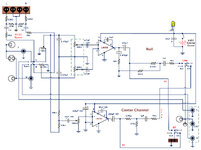K1ngR0y
Junior Member level 1

I put together a circuit which is mainly the combination of two circuits I found on websites.
One is for inversion (inverting the left channel, combining it with the right and getting the result).
The other is a center channel.
The designs appeared in several places and seemed to be recognized as correct.
So all I really did was join them and add a bulb and a few switches.
When I connect a small 8 ohm speaker all I get is a hum. And this occurs even without input.
I am using two LM386 ICs which are mounted in sockets (to avoid soldering the IC leads directly).
They're tiny so I had to take care not too short any.
The connections have been tested for continuity (with the leads) and discontinuity (among the socket leads).
Does anyone have any ideas how to go about debugging this?
One is for inversion (inverting the left channel, combining it with the right and getting the result).
The other is a center channel.
The designs appeared in several places and seemed to be recognized as correct.
So all I really did was join them and add a bulb and a few switches.
When I connect a small 8 ohm speaker all I get is a hum. And this occurs even without input.
I am using two LM386 ICs which are mounted in sockets (to avoid soldering the IC leads directly).
They're tiny so I had to take care not too short any.
The connections have been tested for continuity (with the leads) and discontinuity (among the socket leads).
Does anyone have any ideas how to go about debugging this?


